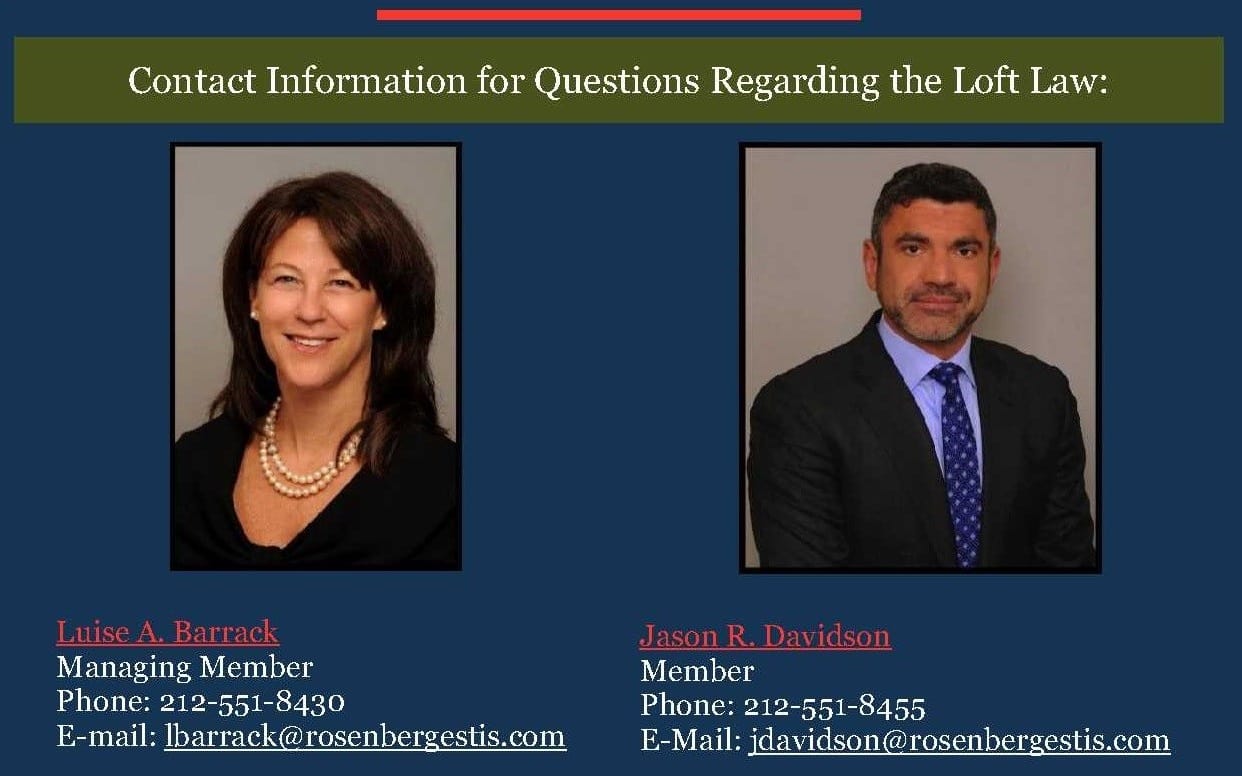- Rosenberg & Estis, P.C. Newsletter || Volume 3 (Full PDF)
January 2018
Newsletter Exclusive Article:
The Everexpanding Loft Law
written by Luise A. Barrack and Jason R. Davidson
Article 7-C of the Multiple Dwelling Law (the “Loft Law”) was enacted in 1982. The Loft Law brought under its jurisdiction spaces that lacked a residential certificate of occupancy, were previously used for commercial, warehousing or manufacturing purposes, and were residentially occupied by three families living independently from one another during the period from April 1, 1980 to December 1, 1981 (the initial “window period”). The Loft Law also established the Loft Board, which was charged with overseeing and coordinating the legal conversion of these Interim Multiple Dwellings (“IMDs”) to legal residential spaces. The Loft Law mandated that owners of IMDs register the units at the Loft Board. The Loft Law was supposed to sunset after loft owners achieved code compliance and obtained residential certificates of occupancy for the IMDs.
However, the Loft Law did not sunset. Instead, it has been renewed, amended, and extended. The Loft Law was amended in June 2010 and again in January 2013 (the “Amended Loft Law”). The definition of IMDs in the Amended Loft Law was consistent with the initial definition of IMDs but incorporated spaces that were illegally occupied as dwelling units by three or more families living independently from one another for 12 consecutive months from January 1, 2008 through December 31, 2009 (the “Second Window Period”). Notwithstanding this expansion of covered units, the Amended Loft Law carved out of its jurisdiction units which do not have at least one window facing a street, legal yard or legal courtyard; that are less than 400 square feet and are located in a basement or cellar; or are in an industrial business zone (other than Greenpoint or Williamsburg, North Brooklyn and certain areas of the Long Island City industrial business zone). In addition, it excluded buildings that were used as of June 21, 2010, and continued to be used to the time when the coverage application was submitted, for certain activities which are inherently incompatible with residential use.
Mayor DeBlasio has opined that the Loft Law is too favorable to loft owners and that he intends to support legislation to increase the Loft Law’s scope and enhance the rights of loft tenants. Among the proposed amendments are the inclusion of units in basements or that lack a window, and the addition of yet another window of coverage from 2015- 2016. The first priority of politicians, landlords, and owners alike should be to ensure that tenants do not reside in housing that does not comply with minimum housing maintenance standards and minimum standards for health, safety and fire protection. However, in removing the prior restrictions on basement spaces and spaces without windows, the Mayor is proposing an endeavor that owners may well be incapable of achieving, as the units they will be compelled to legalize may simply be unable to meet the required legal standards, even with major renovations. While Mayor DeBlasio has been crystal clear that he intends, to the best of his ability, to increase rent regulated housing stock in New York City, at what cost are these proposed amendments? For example, many years ago, we represented a loft building owner in which one of the tenants – despite owning a beautiful home in Rhinebeck, New York with a barn in which he created his art – claimed Loft Law status. The subject space was basement space with no windows in which this tenant stored his artwork. The tenant had to access the space by going through a hatch in the floor and climbing down a wooden rung ladder that folded out of the hatch. Under the proposed amendments to the Loft Law, the owner of that building would be compelled to find a way to legalize that space or potentially face fines for failing to do so. We currently have a case in which the tenants did not have a window during the Second Window Period, but installed a cinder block wall in 2014 with windows behind a roll down garage door (which is in the interior of their space) to sustain their application for Loft Law coverage. Again, this would require the owner to make a garage space legal for residential purposes. Clearly, New York City government agencies would never allow a single-family homeowner to convert their garage space into a residential apartment, so why should a loft building owner be compelled to do so?
The Mayor should meet with the owners of IMDs, and fire code and architectural experts, to understand the myriad issues involved in legalization, to help achieve the goal of ensuring that tenants do not reside in unsafe conditions. Simply adding rent regulated housing stock without fully understanding the implications of doing so will not necessarily serve New Yorkers well.

